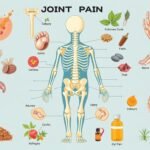Joint pain that lasts can really hurt your body, mind, and social life. This guide explores the causes, symptoms, and natural ways to ease joint pain. Knowing what causes joint pain helps you take care of your joints and improve your life.
Key Takeaways
- Joint pain can come from many sources, like arthritis, inflammation, and musculoskeletal disorders.
- Long-term joint pain can affect how you move, feel, and live your life.
- Natural remedies, like herbal supplements and essential oils, can help your joints.
- Changing your lifestyle, like exercising and managing stress, can also help with joint pain.
- Getting medical advice is key for finding out what’s wrong and getting the right treatment.
Understanding Joint Pain and Its Impact on Daily Life
Joint pain can deeply affect daily life and quality of life. It can make simple tasks hard, cause emotional stress, and lead to feeling isolated. It’s important to understand this to find good ways to manage it.
How Joint Pain Affects Physical Movement
Joint pain can make it hard to move around. Even simple actions like walking or reaching can hurt. This can make it hard to stay active, leading to a less active life.
Emotional and Social Impact of Chronic Joint Pain
Chronic joint pain can also hurt your mind. People with this pain may feel anxious, depressed, and frustrated. It can also make it hard to be social, leading to feeling alone.
Quality of Life Considerations
Joint pain affects your life in many ways. It can make it hard to do things you enjoy or even take care of yourself. This can make you feel less independent and less happy.
Understanding joint pain’s wide effects is key. Healthcare professionals and individuals can work together. They can create plans that help with physical, emotional, and social issues. This can improve life for those with joint pain.
Common Causes of Joint Pain and Inflammation
Joint pain can come from many different conditions. Each one has its own symptoms and ways to treat it. Knowing what causes joint pain and inflammation is the first step to feeling better.
Osteoarthritis is a common cause of joint pain. It often affects the knees, hips, and hands. This condition happens when cartilage breaks down, causing bones to rub against each other and get inflamed.
Rheumatoid arthritis is an autoimmune disease. It makes the body’s immune system attack the lining of the joints. This leads to chronic inflammation, stiffness, and pain. Unlike osteoarthritis, rheumatoid arthritis can affect many joints all over the body.
Gout is another type of inflammatory arthritis. It happens when uric acid crystals build up in the joints, often in the big toe. Symptoms include sudden and severe joint pain, redness, and swelling.
Other common causes of joint pain and inflammation include:
- Bursitis, the inflammation of the fluid-filled sacs (bursae) that cushion the joints
- Tendinitis, the inflammation of the tendons that connect muscle to bone
- Injuries, such as sprains, strains, or fractures, which can cause acute joint pain and swelling
It’s important to know the cause of joint pain to find the right treatment. By addressing the root cause, people can find relief and live better lives.
Identifying Different Types of Joint Pain
Understanding the various types of joint pain can help you manage it better. We’ll look at the differences between acute and chronic pain. We’ll also explore symptoms based on where the pain is and how it feels.
Acute vs. Chronic Joint Pain
Acute joint pain comes on suddenly and is often marked by joint swelling, stiffness, redness, and warmth. It usually happens after an injury or sudden inflammation. On the other hand, chronic pain lasts for weeks or months. It can make everyday activities hard and affect your quality of life.
Location-Specific Joint Pain Symptoms
- Knee pain: Trouble with stairs, getting up from sitting, and less range of motion
- Hip pain: Hard to walk, climb stairs, and less range of motion
- Shoulder pain: Trouble with overhead tasks, reaching behind, and less range of motion
- Ankle and foot pain: Trouble walking, standing, and keeping balance
Pain Patterns and Characteristics
Joint pain can also be described by its pattern and characteristics. Some common patterns include:
- Constant, dull ache
- Intermittent, sharp or stabbing pain
- Pain that gets worse with activity and better with rest
- Pain that gets worse with weather or temperature changes
Knowing the different types of joint pain and their symptoms helps you talk better with your doctor. It also helps you find a good way to manage your pain.
Risk Factors and Prevention Strategies
Keeping your joints healthy is key. Many things can lead to joint pain. Knowing these risks helps you take steps to prevent it.
Obesity is a big risk for joint pain. Being overweight puts extra stress on your joints, especially your knees, hips, and ankles. Eating right and exercising can help manage your weight and lower joint pain risks.
Aging also affects your joints. As you get older, the cartilage that protects your joints wears down. This can cause pain. Staying active and doing exercises that are easy on your joints, like swimming, can help.
Genetics can also play a part. Some inherited conditions, like rheumatoid arthritis or osteoarthritis, can lead to joint problems. Regular health check-ups can help manage these genetic risks.
Occupational hazards are another risk. Jobs that involve repetitive motions, heavy lifting, or standing for long periods can harm your joints. Making your work area ergonomic and taking breaks can help.
By knowing these risks and taking steps to prevent them, you can keep your joints healthy. This helps avoid the pain that can affect your daily life.
| Risk Factor | Preventive Measures |
|---|---|
| Obesity | Balanced diet, regular exercise |
| Aging | Active lifestyle, joint-friendly exercises |
| Genetics | Regular check-ups, early management |
| Occupational Hazards | Ergonomic adjustments, regular breaks |
By tackling these risks and taking proactive steps, you can control your joint health. This reduces the chance of severe joint pain.
“Prevention is better than cure, and the best way to treat joint pain is to prevent it from occurring in the first place.”
Natural Remedies for Joint Pain Relief
Looking for ways to ease joint pain naturally? There are many options to try. From herbal supplements to changing your diet, these methods can help. They also support your joints’ health.
Herbal Supplements and Their Benefits
Some herbal supplements can fight inflammation and ease pain. Turmeric and its curcumin are known for their anti-inflammatory effects. Ginger also helps reduce inflammation and joint pain. Adding these herbs to your routine can help manage joint pain.
Essential Oils for Joint Pain
Essential oils can be applied topically to relieve joint pain. Lavender, peppermint, and eucalyptus oils are good for this. They can help reduce inflammation and soothe aching joints. Massaging these oils on the affected areas can be a natural and soothing way to help.
Dietary Modifications for Joint Health
Eating an anti-inflammatory diet can help your joints. Foods high in omega-3 fatty acids like fatty fish, walnuts, and flaxseeds can reduce pain and inflammation. Also, eating more fruits and vegetables, especially berries and leafy greens, can boost joint health.
| Natural Remedy | Potential Benefits |
|---|---|
| Turmeric | Anti-inflammatory properties, may help alleviate joint pain |
| Ginger | Anti-inflammatory and pain-relieving effects, can ease joint discomfort |
| Omega-3 Fatty Acids | Reduce inflammation, support overall joint health |
By using these natural remedies, you can help manage your joint pain. They also support your overall joint health and well-being.
Exercise and Physical Therapy Approaches
Managing joint pain often needs a mix of methods. Exercise and physical therapy are key in easing pain and boosting joint health. There are many effective ways to try, from low-impact exercises to strength training and physical therapy.
Low-Impact Exercises for Joint Health
Low-impact exercises are great for those with joint pain. Swimming, cycling, and gentle yoga are good choices. They help with flexibility, range of motion, and muscle strength without harming the joints.
These exercises can be adjusted to fit your fitness level and age. This makes them suitable for everyone.
Strength Training for Joint Stability
Strength training is also helpful for joint pain. It builds muscle and makes joints more stable. Exercises that focus on the muscles around the joints can lessen pain and prevent injuries.
It’s crucial to work with a physical therapist or certified trainer. They can help create a safe and effective strength training plan.
Physical Therapy Techniques for Pain Relief
Physical therapy is a valuable tool for managing joint pain. Techniques like manual therapy, joint mobilization, and exercises can enhance joint function and reduce pain. A physical therapist can tailor a treatment plan to meet your specific needs.
“Regular exercise and physical therapy can make a significant difference in managing joint pain and improving overall joint health.”
Combining low-impact exercises, strength training, and physical therapy can help with joint pain. It can also improve your range of motion and keep you active. Talking to a healthcare professional can help find the best approach for you.
Lifestyle Modifications to Manage Joint Pain
Managing joint pain often needs more than just medicine. By changing your lifestyle, you can help control your pain and live better. This section looks at important lifestyle changes for joint pain relief.
Sleep and Rest Recommendations
Good sleep is key for joint health. Try to sleep 7-9 hours each night. Also, keep a regular sleep schedule. Stay away from screens before bed.
Try relaxing stretches or meditation to calm your body and mind before sleep.
Ergonomic Adjustments at Home and Work
Improving your home and work spaces can ease joint pain. Get furniture and tools that support your body, like an ergonomic chair or standing desk. Always sit right and stretch often during the day.
Stress Management Techniques
Too much stress can make joint pain worse. Use yoga, deep breathing, or meditation to relax. Enjoy hobbies and social activities that make you happy and calm.
Focus on sleep, ergonomics, and stress relief to fight joint pain. These changes, along with natural remedies and medical care, offer a full plan for better joint health and life quality.
When to Seek Professional Medical Help
Joint pain can be complex and needs attention when it’s severe. Some pain can be managed with natural remedies and lifestyle changes. But, there are times when you need to see a medical consultation.
If severe pain stops you from doing daily tasks, get medical help. Pain that gets worse, especially with joint deformity or limited mobility, needs a doctor’s check-up.
- Sudden, intense joint pain that comes on without an obvious cause
- Swelling, redness, or warmth in the affected joint
- Unexplained symptoms that persist or worsen over time
- Difficulty performing everyday tasks due to joint pain and stiffness
- A history of joint injuries or conditions, such as arthritis, that have not been properly managed
Ignoring joint pain can lead to more damage and a lower quality of life. Getting professional help can help you find the right treatment. This way, you can manage your pain better.
“Seeking professional help for joint pain is crucial to maintaining your mobility and quality of life. Don’t hesitate to make an appointment if you’re experiencing persistent or severe symptoms.”
Advanced Treatment Options and Therapies
When simple treatments don’t work, doctors might suggest more advanced options. These new therapies can help those with severe joint pain.
Medications and Injections
Medications like NSAIDs or injections of corticosteroids can reduce swelling and pain. They’re used for sudden pain or to help while finding the cause.
Surgical Interventions
For serious damage or deformities, surgery like joint replacement or arthroscopy might be needed. These innovative treatments can greatly improve life for those with severe joint issues.
Regenerative Medicine Therapies
New regenerative medicine methods, like PRP therapy and stem cell treatments, aim to heal joints naturally. These innovative treatments are promising for long-term joint pain relief.
| Treatment Option | Description | Potential Benefits |
|---|---|---|
| Medications | Anti-inflammatory drugs, corticosteroid injections | Reduce inflammation, provide temporary relief |
| Surgery | Joint replacement, arthroscopic procedures | Restore mobility, improve function, enhance quality of life |
| Regenerative Medicine | PRP therapy, stem cell treatments | Promote joint repair and regeneration, offer long-term solutions |
“Advances in joint pain treatment have opened up new possibilities for those struggling with debilitating conditions. By exploring a range of innovative treatments, individuals can find the most suitable solution to manage their joint pain and reclaim their quality of life.”
Conclusion
This article has looked at joint pain from many angles. We’ve covered what causes it, its symptoms, and natural ways to feel better. Understanding joint pain is key to managing it.
Managing joint pain needs a mix of prevention and treatment. We’ve talked about common causes and how to identify your pain. We’ve also discussed natural remedies and how exercise and lifestyle changes can help.
The best way to handle joint pain is by working together with doctors and healthcare teams. Spotting early signs and getting medical help when needed is crucial. This way, you can live a more active and vibrant life. Taking care of your joints is a journey. By using a holistic approach, you can find lasting relief and improve your life quality.
FAQ
What are the most common causes of joint pain?
Joint pain can come from many sources. This includes osteoarthritis, rheumatoid arthritis, gout, bursitis, tendinitis, and injuries. Knowing the cause is key to managing it well.
How can I identify different types of joint pain?
There are two main types of joint pain: acute and chronic. The pain’s location and how it feels can tell you a lot. Look for swelling, stiffness, redness, and how well you can move your joint.
What are some natural remedies for joint pain relief?
Natural ways to ease joint pain include herbal supplements like turmeric and ginger. Essential oils and certain diets can also help. These methods can work alongside other treatments.
How can exercise and physical therapy help with joint pain?
Low-impact exercises, muscle strengthening, and improving flexibility can help manage joint pain. Physical therapy can also reduce pain and improve joint function.
What lifestyle changes can I make to manage joint pain?
Making changes to your sleep, work setup, and stress levels can help. These changes can support other treatments for joint pain.
When should I seek professional medical help for joint pain?
See a doctor if your joint pain is severe, doesn’t go away, or if you have joint deformity or limited mobility. Early treatment is important for managing joint pain.





